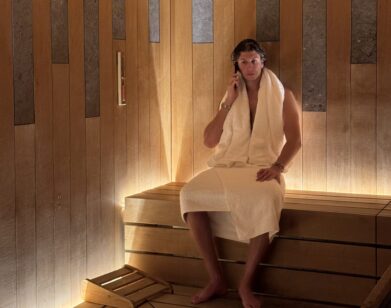In London, Madness Means Business
With grandiose revenue announcements, international stakeholders moving in, and the eternal promise of London’s fashion boom, it could be assumed that the “crazy” factor has all but left the building in the British capital—replaced, perhaps, by staid, sensible, sellable dreams of the tame, trench-coat-and-twin-set variety. The current state of affairs, however, proves London designers are toeing an exacting balance, waving their aspirational wands and cementing individuality like never before.
Some trailblazing proof comes out of East London courtesy of Sister by Sibling, whose Saturday-morning romp, titled “Sophisticated Boom Boom,” sent its knitted universe back in time—landing in lilac, lemon, and denim at a ’50s American Tupperware party. Sound domestic? It was; however, fringe and crystal crocheting updated the wasp-ish silhouettes with aplomb, and a finale of hand-crafted, glittering rosettes adorned cardigans and a swing coat with hydrangea-like bounce—all the more appropriate for bopping along to the B-52s’ soundtrack. Designers Sid Bryan, Joe Bates, and Cozette McCreery turned up their knitting nana-technology yet another notch, with a floating chevron stitch creating undulating, 3-D zigzags.
Looking rather less sunny for Spring ’14 was young designer Phoebe English’s concise edit of smocks and transparent separates—an exercise in awkward manipulation and pallid nude tones that she said was inspired by “desolate and lonely details, harmony and discord.” Set designer David White piled up a mountain of charcoal studded with fluorescent lighting in order to further English’s dystopian vision—one punctuated by violent red macramé shell tops and otherwise subdued in monochrome, raw-edged tulles. English’s work catches a fragile beauty in its pulled and pinched compositions, spelling welcome relief from the embellishment running rife elsewhere.
At John Rocha, New York’s glaring whites crossed the Atlantic via the designer’s native Ireland, caught amongst the brambles to arrive long, sheer, and shredded under his artisanal hand. Known for an ever-present countryside whimsy coupled with bohemian tendencies, Rocha’s fluid silk columns were worked over in georgette petals and glazed lace, with broad-brimmed hats and clutches twisted and looped from organza piping. Dripping with romantic notions and achingly pretty, this latest outing, one of his most classical shows to date, steered away from the deconstruction that marked past collections.
Another designer making a soft return for spring is Burberry Prorsum’s Christopher Bailey, whose petal-strewn finale in Kensington Gardens was a standout amongst the week’s many floral fanfares. Without a classic trench in sight, Bailey paraded cashmere and suede trapeze coats in bubblegum pastel hues, knot-backed sweaters paired with basket-lace pencil skirts and a polka-dot passage reminiscent of the artist David Hockney’s ubiquitous scarf-and-cap combo. Undercutting the cloying sweetness, Bailey studded belts, clutches, and cocktail shifts with rubber daisies and rhinestones—injecting a much-needed textural edge to the collection’s prim garden-party atmosphere.
If Burberry was all English spring garden, then Scottish designer Jonathan Saunders countered with hothouse tropical, with his Technicolor offering at the Tate Britain marking his first decade in the business. Celebrated as one of London’s uptown and upbeat commercial success stories, Saunders flaunted his luscious color wheel with psychedelic panache. This editor envisaged a desert road trip from L.A. to Vegas, with desert flowers opening after summer rain—and a rainbow, too, thrown in for good measure. Slinky pajama trousers and diaphanous shirting tripped the light fantastic in poppy prints and embroideries, with degrade ruffles cascading down flippy skirts and sundresses. Riffing on menswear jacket shapes (a trick Erdem Moralioglu also explored in opulent monochrome), Saunders opened with a trio of paneled suede blousons and closed with pastel silk bombers bursting with digital blooms.
Speaking of Jonathans, investment rumors from French luxury conglomerate LVMH quelled none of the renegade spirit in Irish wunderkind J.W. Anderson’s collection, which read as a stellar exercise in subverting archetypal silhouettes and fabrics. Despite a traffic-light trio of sequined skirts, a staid palette of monochromes, brown, and navy grounded his technical propositions in pleated, ruched, laced, sliced, and draped fabrics like leather, pleather, and nylon. Claiming inspiration from what he called “modern peasantry,” Anderson’s garments (while often clinical) were imbued with a subservient air—owing to the long, ballooning skirts and tabard tops paired with pool sandals. The cascading, fringed capes and spaghetti-strapped columns were where the “emotional femininity” of his show notes truly flourished.
Closing out the week were London’s heretical historians Meadham Kirchhoff, whose catwalk was strewn with (you guessed it) flowers. They were red and white roses, in fact—wilting as if by the sheer reverberations of the human heartbeats that echoed over the Batman-laced soundtrack. Running riot with pagan imagery across their embossed, wax-sealed invites and opting for Penhaligon’s intoxicating “Castile” to scent the show, Edward Meadham and Benjamin Kirchhoff departed from a dark, Elizabethan nightmare of severe bouclé tailoring through to a celebratory passage of pearled handmaidens. Flashes of gold and black python contrasted a vampish sexuality against the duo’s signature Lolita smocks and pinafores—the opulence of their hand-cut lace and chiffon bound by gilded corsets and box-pleated kilts. For that reckless, delicate kind of splendor, you could ask no one else.







